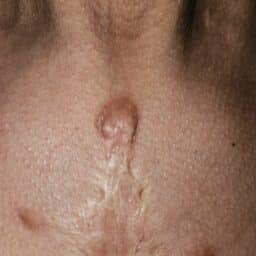The process of keloid formation is complex and involves various types of cells and molecular factors. While the exact cause of keloid formation is still not fully understood, it is believed to be related to the body’s healing process. When there is an injury or damage to the skin dermis, the body’s immune system responds by sending immune cells such as macrophages to the site of injury. These cells release signaling molecules that stimulate fibroblasts, which are cells responsible for producing collagen and other extracellular matrix proteins.
After the initial inflammatory response, fibroblasts differentiate into myofibroblasts, which are specialized cells that help to close the wound. These cells also produce excessive amounts of collagen and other matrix proteins, which leads to the formation of a thick and raised scar that is often called a benign fibrous tumor. In the case of keloids, this process of collagen production continues even after the wound has healed, causing an overgrowth of fibrous tissue that extends beyond the initial area of skin injury.

Several factors have been identified as contributors to keloid formation, including genetics, skin tension and infection. Keloids are more common in people with a family history of keloids or those with darker skin tones. Abnormalities in genes that regulate collagen synthesis and degradation have also been found in patients with keloids. Additionally, keloids are more likely to occur in areas of the skin that experience high levels of tension, such as the chest and shoulders. Finally, chronic inflammation or infection due to acne, ingrown hairs or allergic contact dermatitis can also contribute to the development of keloids. Keloid formation is also influenced by changes in hormone levels which occur during puberty and pregnancy.
Contact Keloid Academy for more information.